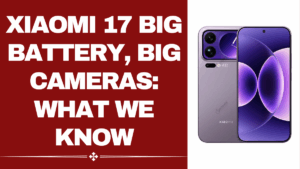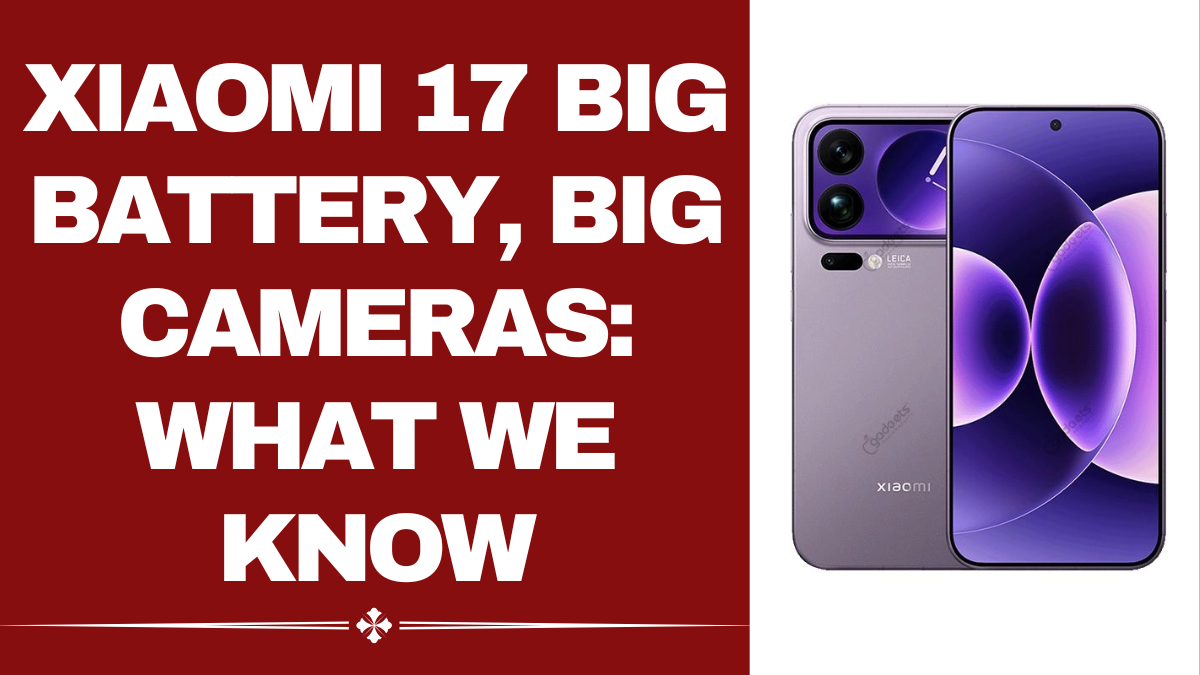The smartphone race in 2025 is heating up, and Xiaomi is stepping into the spotlight with its much-anticipated Xiaomi 17. Known for packing cutting-edge hardware at competitive prices, Xiaomi is once again aiming to dominate with a phone that could redefine endurance and camera quality. Rumors and leaks suggest the Xiaomi 17 will come with a massive 7000mAh battery, triple 50MP camera system, and Android 16 right out of the box. If true, this could make it one of the strongest contenders in the Android flagship arena.

Xiaomi 17 Key Highlights
Here’s a snapshot of what’s expected in the Xiaomi 17:
-
7,000mAh battery, one of the largest in any mainstream flagship
-
Triple 50MP camera setup covering wide, ultra-wide, and telephoto needs
-
Snapdragon 8 Elite Gen 5 processor for flagship-level performance
-
6.8-inch AMOLED display with 120Hz refresh rate
-
MIUI 17 skin running on Android 16
-
Super-fast wired charging and improved wireless charging
-
Sleek design with aluminum build and Gorilla Glass Victus protection
Design and Build
Leaks show the Xiaomi 17 will sport a premium aluminum chassis with a glass back panel, featuring bold color options like Midnight Black, Ice Blue, and Sunset Gold. The design is rumored to be slimmer than the Xiaomi 16 despite packing a much larger battery. Xiaomi seems to be going for a flat-edged modern aesthetic, resembling a mix of its Note series and flagship Mi series. Bezels are expected to be razor-thin, with a centered punch-hole selfie camera and curved edges on some models.
Display Experience
The Xiaomi 17 is expected to feature a 6.8-inch AMOLED display with 120Hz adaptive refresh rate. Early whispers suggest brightness levels crossing 2000 nits, making it excellent for outdoor use.
Display highlights include
-
QHD+ resolution for sharp visuals
-
HDR10+ and Dolby Vision support for enhanced video playback
-
Adaptive LTPO tech to save power by adjusting refresh rate from 1Hz to 120Hz
-
Improved touch response for gamers and heavy users
This makes the Xiaomi 17 one of the most display-friendly devices in its price class.
Camera System: Triple 50MP Power
Xiaomi has been pushing into camera innovation, and the Xiaomi 17 continues this trend. The triple 50MP system is designed for versatility.
| Camera | Specs | Features |
|---|---|---|
| Main | 50MP wide sensor | Improved low-light shots, AI HDR |
| Ultra-Wide | 50MP sensor | 120° field of view, macro improvements |
| Telephoto | 50MP lens | 5× optical zoom with AI stabilization |
On top of the hardware, Xiaomi’s AI imaging software will boost results with features like real-time night enhancement, motion detection for action shots, and auto-suggested editing. Video capabilities may include 8K at 30fps and 4K at 120fps with advanced stabilization.
Battery: The 7,000mAh Beast
The standout feature of the Xiaomi 17 is its 7000mAh battery—a figure that dwarfs many competitors. If true, this could make it the battery champ of 2025.
Battery expectations include
-
2-day endurance with normal use
-
All-day gaming or streaming without top-ups
-
120W wired charging that goes from 0 to 100% in under 25 minutes
-
50W wireless charging for convenience
-
AI adaptive power management with Android 16
This makes it perfect for power users who hate carrying power banks.
Xiaomi 17 vs Samsung Galaxy S25 vs iPhone 17
How does the Xiaomi 17 stack up against its biggest rivals?
| Feature | Xiaomi 17 | Galaxy S25 | iPhone 17 |
|---|---|---|---|
| Processor | Snapdragon 8 Elite Gen 5 | Snapdragon 8 Elite Gen 5 | A19 Bionic |
| Display | 6.8-inch AMOLED, 120Hz | 6.2-inch AMOLED, 120Hz | 6.1-inch OLED, 120Hz |
| Cameras | Triple 50MP system | Dual 50MP | Dual 48MP Fusion |
| Battery | 7000mAh, 120W charging | 4200mAh, 45W charging | All-day battery, MagSafe |
| OS | Android 16 + MIUI 17 | Android 16 + One UI 7 | iOS 19 |
From this comparison, it’s clear that the Xiaomi 17’s battery size and camera versatility stand out the most.
Performance and Software
The Xiaomi 17 is expected to run on the Snapdragon 8 Elite Gen 5, Qualcomm’s most advanced chipset to date. Paired with MIUI 17 and Android 16, the phone will deliver faster multitasking, more stable gaming, and deeper AI-driven optimizations.
MIUI 17 is said to introduce
-
AI scene-based enhancements for smoother usage
-
Contextual app suggestions powered by machine learning
-
Improved customization and personalization options
-
7 years of security updates with at least 5 years of major OS updates
This puts Xiaomi closer to Samsung and Google in terms of long-term support.
Who Should Buy the Xiaomi 17?
The Xiaomi 17 is designed for users who prioritize battery endurance and camera versatility. It’s perfect for
-
Power users who want multi-day battery life
-
Travelers who rely on long-lasting devices without frequent charging
-
Creators who want triple-lens versatility with high megapixel counts
-
Gamers who need a large display and stable performance
Budget-conscious buyers will also appreciate Xiaomi’s history of pricing aggressively, making this one of the best value flagships.
Conclusion
The Xiaomi 17 is shaping up to be one of the most exciting Android phones of 2025. With its enormous 7000mAh battery, triple 50MP camera setup, and flagship Snapdragon 8 Elite Gen 5 processor, it offers a combination of endurance, photography, and performance that rivals will struggle to match. While Samsung and Apple still dominate ecosystems, Xiaomi’s approach to hardware strength at competitive pricing could make the Xiaomi 17 the go-to choice for battery-conscious power users this year.
FAQs
How big is the Xiaomi 17’s battery?
It is expected to feature a massive 7000mAh battery, making it one of the largest in any flagship.
Will the Xiaomi 17 support 120W charging?
Yes, leaks suggest 120W wired fast charging and 50W wireless charging.
Does the Xiaomi 17 support 8K video recording?
Yes, it is expected to support 8K video at 30fps with AI-driven stabilization.
Is the Xiaomi 17 worth buying over the Galaxy S25?
If you value battery endurance and camera versatility, the Xiaomi 17 offers more. The Galaxy S25, however, has the advantage of Samsung’s ecosystem and Galaxy AI.
Click here to know more.
